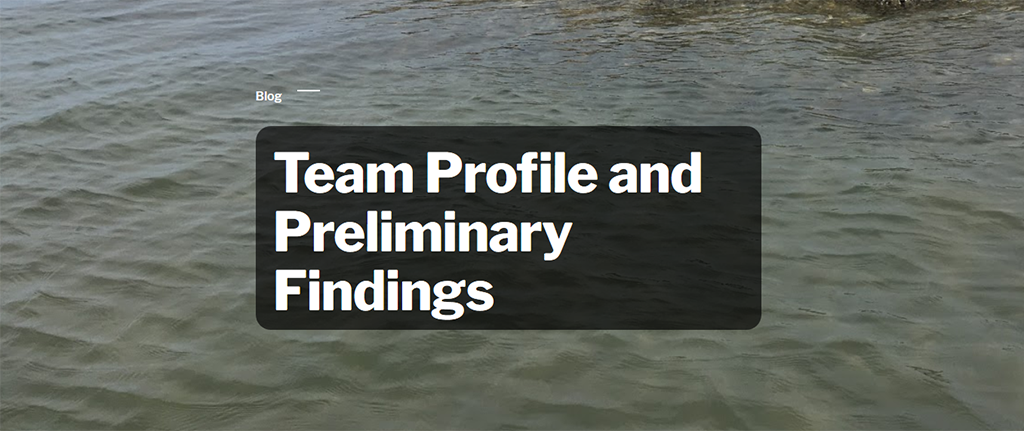Tools for Conserving Coastal Ecosystems
Project Team

Team profile by Eve Adelson, Catherine Bailey, Melissa Baldino, Molly Bruce, Avery Indermaur and Haynes Lynch
Oysters are an important component of many coastal ecosystems and a lucrative economic resource for many coastal communities. Oysters are ecosystem engineers that build on one another to provide critical habitat for fishes and invertebrates. Oyster reefs protect shorelines from the impacts of severe storms, improve water through filtration, and sequester carbon. However, despite their ecological value, oyster populations have declined precipitously over the last 130 years, decreasing by an estimated 85%.
Despite the importance of oysters, there are many shortcomings in current oyster reef biodiversity assessment methods––methods that would enable coastal managers to restore and conserve remaining oyster reefs. For instance, current assessment methods are time-intensive, costly, dependent on weather conditions, and destructive to existing habitat. With these shortcomings in mind, our team worked on developing novel methods that leverage remote, less invasive technologies such as passive acoustics and aerial imagery to produce robust, rapid, and cost-effective assessments of oyster reef health and biodiversity. Specifically, our team used Autonomous Reef Monitoring Structures (ARMS), unoccupied aerial vehicles (UAVs), and passive acoustic monitoring to assess the health and biodiversity of three oyster reefs in the Rachel Carson Reserve off the coast of Beaufort, North Carolina.
Autonomous Reef Monitoring Structures (ARMS) & Traditional Quadrat Surveys
ARMS are stacks of 9 PVC plates that are arranged to mimic the structural complexity of a reef and used by scientists as a standardized way to measure marine biodiversity. ARMS are deployed on a reef and left for months to years. Over time, invertebrates settle and grow on the structures, creating a micro-community representative of the area around them. The ARMS are then collected and every organism is accounted for using visual and genetic techniques to estimate local biodiversity. Researchers have primarily used ARMS to study coral reef biodiversity, but they may also be useful on temperate oyster reefs to quantify reef-associated diversity. However, before they can be implemented as a widespread tool they need to be compared to more extractive, conventional methods. Thus we also surveyed each reef using random quadrats (i.e. excavating a few representative chunks from each reef and counting all of the organisms in each chunk). These data allow us to both (1) compare whether ARMS are a viable non-destructive alternative to traditional quadrat surveys and (2) examine how the different diversity metrics relate to sound and UAV-based metrics. Check out the video below to see one of our ARMS in turbid, North Carolina waters and the photo below to see what a quadrat looks like.

Unoccupied Aerial Vehicles (UAVs)
Using two-dimensional, georeferenced UAV imagery, we created 3-D renderings of oyster reefs through a process called Structure from Motion, in which we used the software package Pix4D to identify unique pixel clusters across multiple images, examine the relative positions of these unique pixel clusters, and output an orthomosaic of each reef.
Passive Acoustic Monitoring
We deployed a hydrophone on three different oyster reefs - one recently constructed reef, one reef that was constructed over a decade ago, and a natural reef. We quantified different qualities of the recorded soundscape, such as the intensity and frequency distribution of the sound. By comparing the soundscapes to 1) the biological communities measured by using quadrats and ARMS and 2) the habitat structure measured using UAVs, we can develop passive acoustic monitoring proxies to assess reef health and biodiversity.
Social Survey
Our team also conducted a social survey in order to assess managers’ impressions of these innovative monitoring methodologies. Through outreach, we were able to talk with 9 managers across a handful of organizations. Broadly, though these managers were excited about the prospect of incorporating innovative, remote technologies into their restoration and conservation efforts, many of them also flagged two central limitations: time and money. In fact, many of these managers don’t conduct regular and rigorous evaluations of their reefs because many of their grants don’t provide funding for this longevity of attention. For those managers who did have regular monitoring regimes, many of them relied on volunteers to do this work. That being said, many of these managers also had dependable partners at a range of academic institutions and surmised whether there weren’t opportunities to incorporate these efforts by way of university partners.
Between Hurricane Dorian and COVID-19, our team learned to be adaptive--we would be remiss not to acknowledge the impact of both Hurricane Dorian and COVID-19 on our team’s plans. In the Fall, our team had intended to begin passive sampling. However, because of Hurricane Dorian in September 2019, we had to pull up the ARMS we had deployed in April 2019 and start again from scratch. In the face of this unforeseen event, we (1) started a new side project looking at how thermal buffering is related to reef diversity and whether remotely-sensed thermal metrics are good proxies for reef temperatures and (2) pushed back our project timeline by ~5 months. This altered timeline meant that our big ARMS recovery field trip was pushed to April 2020 and was ultimately cancelled when the COVID-19 outbreak began. The outbreak also prevented us from finishing our diversity processing in the lab and transitioned all of our meetings online. That said, we are optimistic that with an extended timeline we will still be able to finish most of the work.
See the team website for more information and preliminary findings, including sections on the role of thermal buffering in reef community composition, reef acoustics and future directions.

